Are you trying to save money on the investment of equipment like a tent? Maybe you just want to explore nature the way it was meant to be enjoyed. Either way, tentless camping is growing in popularity, but many campers don’t know how to do so safely and comfortably.
If you camp without a tent, you’ll want to bring a ground tarp, hammock, or bivy sack. Sleeping pads and a sleeping bag or blankets can keep you comfortable. Protect yourself from animals and insects. Get off the ground wherever possible and stay active through the night to keep warm.
For more tips on how to camp without a tent, here is what you need to know to make your next excursion more successful.
How to Camp Without a Tent?
Whether you lack the funds to invest in a good tent or just want to try to rough it in the great outdoors, tentless camping might appeal to you.
However, there are some key precautions you’ll want to take and items that you’ll want to be armed with before you head to the campsite.
Fortunately, the investment in camping gear for tentless camping isn’t going to cost you much.
Here is a breakdown of what you may need and what you can do to stay as comfortable as possible, even without a necessary item like a tent.
1. Always Bring a Ground Tarp
While you might be able to get away without a tent for cover, you likely don’t want to sleep on the ground directly. Not to mention, storing your gear on the ground gets it dirty.
If you spend your hard-earned cash on the gear you own, you want to protect its longevity. This is where a ground tarp can come into play.
Carrying a tarp from your car to your campsite doesn’t add much bulk or weight to your pack. For a minor inconvenience, it’s a great way to protect you and your gear from unnecessary wear and tear.
This keeps you from laying in dirt, leaves, and puddles if the weather turns out to be worse than you imagined. Not to mention, your ground tarp can serve another function.
If it starts to rain on you while you happen to be out tentless, you can use some paracord to string it up and protect you from the worst of the rainfall.
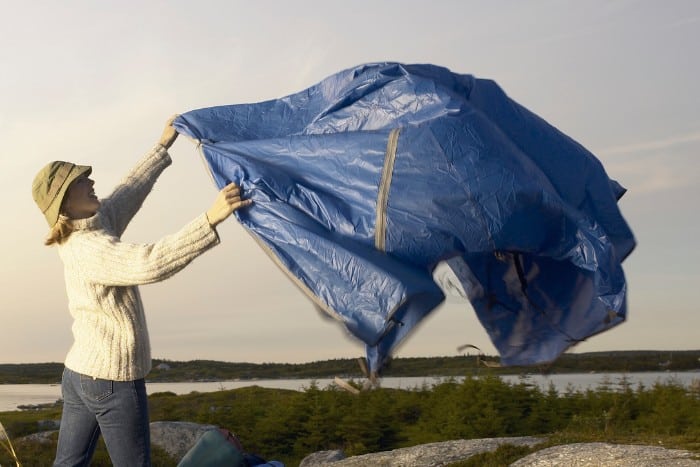
2. Invest in a Sleeping Pad
Even if you sleep in a tent, a quality sleeping pad should be an essential item on your must-have list.
A sleeping pad keeps you off the ground and prevents your body heat from transferring to the cold, hard ground.
You’ll want a sleeping pad in your pack if you are camping in the middle of winter when temperatures drop. Plus, it keeps you from rolling directly into a face full of leaves and twigs.
3. Bring a Mosquito Net
One of the major complaints that people have about tentless camping is that there’s little to no protection from insects.
Those pesky mosquitos and gnats can keep you up all night and make you itchy during the day. A simple solution to keep bugs at bay while you’re tentless camping is to pack a small mosquito net.
You can hang this from a branch on a tree that you’ll sleep under. Alternatively, you could string it up with some paracord.
Either way, you’ll be grateful to have some protection from the bugs without sacrificing your tentless camping experience.
4. Prepare Your Sleeping Equipment
Tentless camping means you will be more exposed to the elements than you would be on a typical camping trip.
That means you need to plan for nighttime when temps start to drop. Invest in a quality sleeping bag rated for the temperatures you’re likely to see while on your trip.
Many people prefer down sleeping bags because they’re lighter and take up less room in a full backpack.
You might need a zero-degree bag if you’ll be camping in the winter, but you can get away with other sleeping arrangements in the spring and summer.
For example, many people make do with a sleeping bag liner in the summer. If you don’t want to invest in any sleeping equipment, you can also use a few blankets and quilts to keep you warm at night.
These may be more convenient if you use a tent alternative such as a hammock.
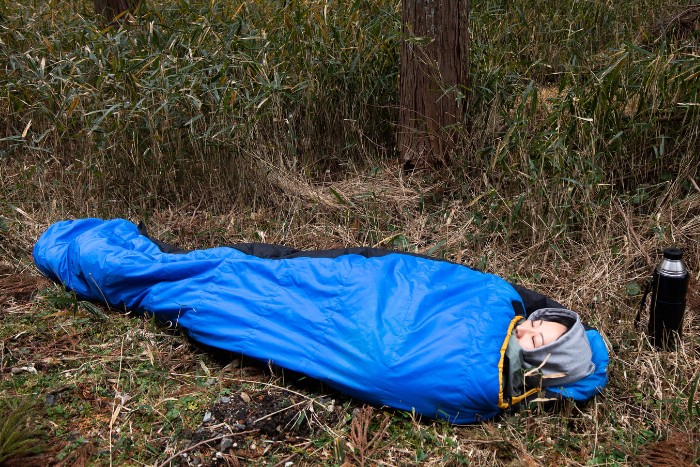
5. Use a Hammock
If you aren’t keen on laying directly on the ground without the protection of a tent or a tarp, then you might want to invest in a hammock instead.
This is an extremely lightweight item to add to a backpack. You’ll be much more comfortable on your camping trip, as you won’t sleep on the cold, hard ground.
Instead, you’ll be suspended in the air and are less likely to wake up sore.
Remember that a hammock will keep you from laying in a puddle of water if it rains, but there’s no protection from above if it starts to rain.
Many campers prefer to pair their hammock with a cheap rainfly draped over the top and secured with paracord. As a bonus, a rainfly can keep debris from falling on you at night.
Trees that are shedding their leaves and foliage won’t be able to force you to sleep with them. This is another great way to minimize the gear you’ll need to purchase for a camping trip.
A hammock makes a sleeping bag unnecessary, as you can sleep with blankets from home. While it may be a bit more expensive than a tarp for the ground, it’s a great investment.
6. Sleeping in Your Car
Of course, there’s another option for tentless camping if you aren’t a fan of the bugs or weather: you could always sleep in the car.
This allows you to set up an air mattress across the backseats or in the bed of your truck. Recline the seats and load up on blankets and pillows for a cozy night.
Sleeping in the car will protect you from some elements, namely the wind and rain. If it’s cold in the winter, you’ll have a refuge from the ice, snow, and wind.
7. Bivy Sacks
If you want some protection from the weather without needing a full tent, you might want to consider a bivy sack. You can sleep in these weatherproof containers with your sleeping bag.
Because they provide some shelter, you can rest easy no matter what the bugs or weather may do all night long. You can invest in a bivy shelter for campers who also want some protection for their gear.
Much like the bivy bags, these shelters are still weatherproof and breathable, but they come with poles that allow you to store your gear inside.
It won’t be the most spacious experience you’ve ever had, but it’s a great option when the elements just won’t cooperate for simple tent camping.
It’s a way to protect yourself from rain and bugs, as well as protect your investment in your equipment.
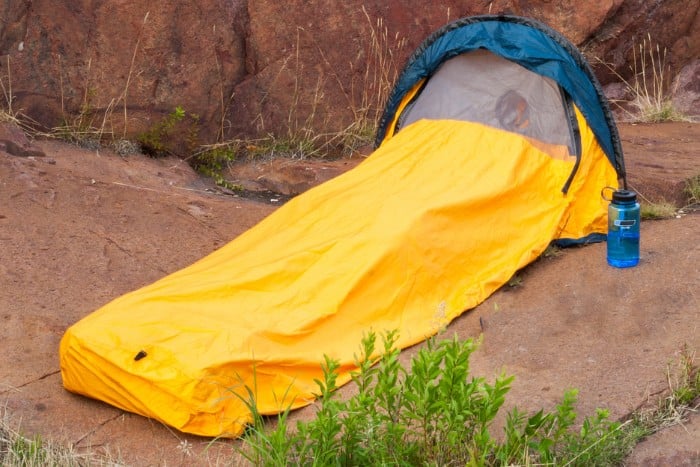
8. Sleep Directly Under the Stars
While there are tons of alternative solutions for those who want to experience tentless camping, nothing beats the simplicity of sleeping directly under the stars.
You don’t need fancy equipment to enjoy a weekend camping trip, as long as the weather is nice. Bring a couple of blankets or your sleeping bag and set up camp next to your campfire.
The benefits of this style of “cowboy camping” are many:
- You can minimize the investment in your equipment.
- You won’t have as much to carry to the campsite.
- You’ll save tons of time on the actual setup of your camp.
Remember that roughing it this way may not be the most luxurious camping experience you’ll ever have. If you’re accustomed to glamping, this cowboy camping style might be too much of an adjustment.
However, if you’re used to survivalist camping or want to try your hand at it, this is the simplest and easiest way to camp without a tent.
9. Set Up for Survival
Suppose you get to your campsite and realize that bad weather is rolling in. If you have no tent, you might be tempted to pack it up and call it a day.
However, you’d miss out on some serious fun, as camping in a storm can be a beautiful experience. For those with experience camping, you might want to try setting up a survivalist campsite.
You still won’t bring any extra equipment into nature with you.
Instead, you’ll use only what you can find on the campsite, whether that means fallen trees, limbs, a hollow in the side of a hill, or whatever else you can find.
It stretches that creative muscle as well as saves you money on gear. The only downside is that this type of camping takes a great deal of setup time.
If you’re in the woods and it starts to rain, this isn’t the ideal time to start setting up a shelter. Instead, you’ll want to do this first when you arrive at the campsite.
It’s good practice for those who want to test and hone their survival skills.
10. Protect Yourself from Animals
One of the biggest challenges facing tentless campers is the possibility of wildlife interfering with a good night of sleep.
The good news is that animals often steer clear of campsites because they’re used to people being there. However, you may not have this luxury if you plan to camp without a tent in a place off the beaten path.
The best thing you can do is ensure your campsite is as unappealing as possible for animals. You don’t want to lure them in with the smell of food, cooking utensils, and more.
Ensure that your smelly goods are packaged in animal-safe containers that don’t allow odors to escape.
Don’t forget to pack other items that can ward off wildlife, like flashlights and whistles.
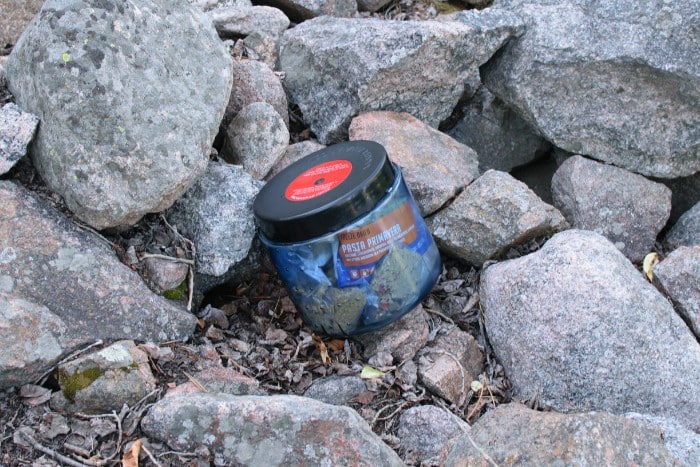
11. Check for Ant Hills First
Don’t wake up in the middle of the night to a stinging pain that covers your body.
Sleeping too close to a fire ant pile can be uncomfortable and painful, leading to more issues that make your trip a nightmare.
You have to be extremely cautious about where you position your sleeping setup if you won’t be using a tent to keep some of these critters at bay.
Inspect the soil around where you’re thinking about sleeping. If it looks like it might be home to a pile of fire ants, relocate as quickly as possible.
12. Get Off the Ground
Especially if you’ll be camping in cold weather, the best thing you can do to keep yourself warm and comfortable is to get your body off the ground.
You lose much of your body heat through transference to the ground you sleep on. If you can keep yourself up and away from this phenomenon, you’ll be in a much better spot to stay warm.
A sleeping pad is one way to do this, but you might want extra protection. You can also build a small platform using what you can find in nature.
Rearrange some logs and sticks to get yourself up off the ground. Even arranging a small pile of pine needles underneath where you’ll be sleeping is a great way to protect yourself.
It might not be the most comfortable night you’ve ever spent in the wild, but it can keep you warm if you don’t have a high-quality sleeping pad.
You can also ensure that your platform is close to your fire for added warmth.
13. Stay Active
Especially if you’re winter camping without a tent, you’ll want to consider what you can do to stay warm. Chances are that you won’t be comfortably tucked into your sleeping bag for twelve hours straight.
Instead, you should prioritize staying busy for as much time as possible.
What does this do for your camping experience? It means your body isn’t in rest mode, where the core body temperature drops. Instead, you’ll be in a prime position to stop the shivering and start camping.
That might mean that you need to bring lanterns for when those nights come super early.
This could be a great investment as it gives you more time and freedom to explore your hobbies while still staying active and getting the blood pumping.
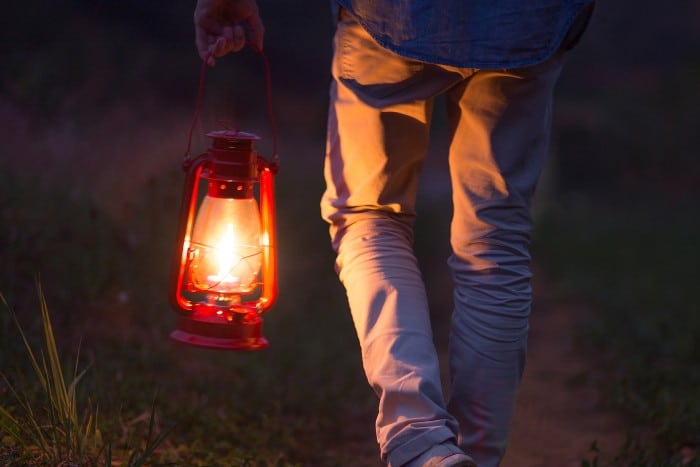
Final Thoughts
Tentless camping can be a lot of fun if you want to connect with nature, cut back on the gear you have to pack, and save money on buying a tent.
However, you need to consider many things before you hit the road. Prepare yourself with the supplies you’ll need to stay comfortable and warm.
With these items in your backpack and some precautions, you may never camp with a tent again!
